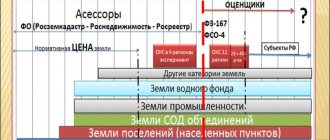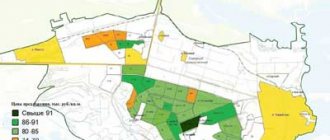The cadastral value is understood as the price of a plot, which is established after a state assessment , which determines individual indicators on the basis of which the price is calculated for specific categories of plots.
In addition to the cost values established at the federal level, certain types of prices can be established as a result of consideration of individual cases in disputes initiated by plot owners.
How often does it change?
Cadastral value indicators have different values for individual categories of land, mainly differing in their purpose or useful quality .
From time to time, prices for certain categories of plots are revised. This is often due to the fact that key indicators change over time, which have a significant impact on its value.
In general, the revaluation procedure is determined by Federal laws, and the terms themselves are established by the State Real Estate Cadastre.
There are time frames within which the cadastral value revaluation procedure is carried out.
Thus, the maximum period is limited to 5 years , and the minimum is 2 years - in this case, the main factor on which they rely when revising prices is the region in which the site is registered.
In some cases, the revision of the cadastral value may be initiated ahead of schedule .
In particular, such cases may be:
- Changing the area of a plot of land towards decreasing or increasing;
- Carrying out land surveying;
- Changing the purpose of areas. For example, the conversion from land for growing crops to plots for individual residential construction automatically increases the price;
- Commissioning of a facility built on a specific plot of land. As a rule, such actions significantly increase the price of the plot;
- With significant development of infrastructure around the land plot, since the presence of hospitals, schools, kindergartens and other facilities in close proximity to them significantly increases its value;
- Changes in indicators at current market prices.
Revaluation of land for previous years
A massive revaluation of land was carried out back in 2014 , and the result was such that in some regions the calculated figure significantly exceeded the market value of the plots.
This situation led to the fact that the owners of many plots, who did not agree with this fact, considered the increase to be unjustified, and initiated a large number of legal proceedings to challenge the value established at the state level.
An equally significant change in the cadastral value was the amendments to the laws introduced in December 2016 , when there was a significant increase in indicators for all categories of land plots.
How cadastral value and land tax are related: basic formula
The cadastral value of a land plot (hereinafter referred to as the CV) must reflect its real market value. It participates in the formula for calculating land tax (hereinafter - ZN):
ZN = KS × CH,
where CH is the land tax rate.
This formula is valid for the situation when:
- information about the KS is reflected in the state register before the start of the reporting period (the KS is included in the calculation as of January 1 of the reporting year);
- the KS indicator did not change during the accounting year.
See the Ministry of Finance's plans for land benefits here .
Find out what formulas you need to use if the CS has changed in the following sections.
Forecast
According to the adopted Federal Law No. 360 dated July 3, 2016, with amendments currently in force in all regions, the growth of cadastral value has been suspended for some time - it will not be revised until January 1, 2021 .
At the end of this period, the price for plots will be revised, but in accordance with Federal Law No. 237 “On State Cadastral Valuation”, this process will be carried out by independent public sector institutions under the supervision of Rosreestr.
Sales story
Why then was it necessary to make more changes when everything seemed to be going well anyway?
Victoria Abramchenko: The amendments are aimed at resolving several unresolved issues. The first is to give rights holders a real opportunity to influence the assessment before it is accepted. The second is to give the regions tools to correct old mistakes. Third, increase responsibility for assessment results and improve the speed and quality of correction of possible errors. Fourth, apply the corrected cadastral value instead of the corrected one in accordance with the principle “any error is in favor of the copyright holder.” Fifth, move to a single forecasted cadastral valuation cycle in all regions of our country. And finally, sixth, to reformat the commissions for reviewing disputes regarding cadastral valuation in such a way that the mechanism for out-of-court determination of market value becomes truly accessible and fair to all rights holders.
It is important that the changes do not concern the assessment procedure itself—professionals must and do work within the process. Our task is to set up the process in such a way that these professionals understand the degree of responsibility for the results of their work, so that it is simply unprofitable to make mistakes.
The purpose of the amendments to the law is, first of all, to give copyright holders a real opportunity to influence the assessment of their plots and houses before its approval
In addition, the proposals of budgetary institutions conducting cadastral valuations were taken into account. The bill provides for the provision of a list of all real estate objects in the region in preparation for the assessment, as well as the provision of information to budgetary institutions on the prices of transactions with real estate objects.
Here we should also mention the development of methodological guidelines, to which we also try to pay maximum attention with the involvement of the best specialists from regional institutions, universities, and appraisers. As a result, the results of the cadastral valuation must be fair in all cases.
It is no secret that citizens sometimes, when making a purchase or sale transaction, do not indicate the true value of the property. What could this mean for ordinary citizens?
Victoria Abramchenko: In the Saratov region, when we were solving the problem of defrauded shareholders, similar speculation was discovered with undervaluation of real estate. And the citizens whom the state needed to protect found themselves in a trap, since they themselves went so far as to indicate an undervalued value in sales contracts. It's best to be honest when it comes to real estate. Otherwise, the state will not be able to protect the rights of owners who commit some kind of forgery.
What does the adjustment affect?
The value of the cadastral value has a significant impact on the following points :
- Calculation of payment for land lease under certain conditions;
- The amount of land tax, which is determined as a percentage of the cadastral value.
The most significant in this case is the impact on tax calculation, since almost every owner of a land plot, with rare exceptions of preferential groups, is obligated to make such transfers to the country’s budget.
It is on the basis of the cadastral value of one square meter of land that the total price of the plot is determined by multiplying the land area by a unit of indicator.
The tax is also calculated on the basis of a percentage determined for each individual category of land, while the average rate is at the level of 0.3% and can fluctuate significantly both up and down.
How to change if rights are violated
If prices are significantly inflated, each owner of a land plot has the opportunity to challenge the established value .
To challenge the price, you must first have grounds for such action.
It is worth understanding that the determination of cadastral value is carried out on the basis of specific indicators - location, characteristics of real estate, purpose of the plot, changes in the market.
If the cadastral value of a land plot has changed, and any factors were not taken into account or the data is distorted, the land owner has the right to challenge it.
Where to contact?
At the moment, there are two possible ways to change the cadastral value privately.
- Administrative method . In this case, an application is sent to Rosreestr from the direct owner of the land plot.
- Judicial . Going to court is possible only after a pre-trial settlement of the issue has taken place and Rosreestr has refused such an action.
When applying both administratively and judicially, the owner of the plot must have real grounds for reducing the cadastral value , which can be confirmed either by existing documents or by conducting an additional examination.
What documents are needed to revise the value?
When applying for the need to revise the cadastral value, the list of documentation is as follows:
- Cadastral passport of a plot of land;
- Report on the market price of land;
- Certificate of ownership of land;
- A separate expert opinion in the event that the market price differs from the cadastral price.
There will be a mistake in the price
The new law provides for mandatory public discussion of all versions of the real estate valuation report. It is said that the possibility of his approval in a version that has not been publicly discussed is excluded. Decipher for our readers why real estate valuations without public discussion were dangerous?
Victoria Abramchenko: According to the current mechanism for preparing real estate assessment reports, there may be cases when owners, after a public discussion of draft reports and consideration of relevant comments, discovered as a final report a document that, in its content and the value indicated in it, was radically different from what they had read .
It will now be impossible to approve a version of the report that has not undergone public discussion.
For the convenience of citizens, we have provided a separate report for “household real estate”. Now the cadastral valuation report is one large document, which includes all possible real estate objects: shopping complexes, office and industrial facilities, “domestic real estate”. As a result, people simply cannot find their objects.
How many versions will there be and how will everything work?
Victoria Abramchenko: Each version of the draft report will be available on the website of the budgetary institution for review for all interested parties within 15 days, and the first version - within 30 days. During this period, everyone can familiarize themselves with the project and express their comments on it.
If you do not agree with the stated conclusions, you can submit a comment to the regional budgetary institution. Moreover, you can contact by any available means - either directly to the institution that prepared the report, sending your objections in paper form or by e-mail, or through the MFC.
In the current regulation, you need to have time to familiarize yourself with the next version of the draft report and have time to formulate a comment on it within no more than 5 days. In such a situation, it is difficult to have time to find something and express your disagreement.
Suppose that a citizen saw the assessment of his property and said: gentlemen, you incorrectly assessed my plot or my property - yesterday there was a park under the windows, and today there is a highway that is noisy. I would like the cost to be reduced. Can he send you such a complaint?
Victoria Abramchenko: Not to us. Such an appeal must be sent to the regional budgetary institution that deals with cadastral valuation. You also need to understand the difference: you made a mistake when making the assessment, or today the market is different - the object has changed its value. For one and the other case, the bill offers its own solutions.
If a mistake is made, it must be corrected. To do this, you submit an application for correction of the error to the regional budgetary institution, and it corrects the error. Moreover, the institution’s responsibilities also include correcting errors in neighboring facilities.
Let’s say that during the assessment they made a mistake taking into account the gas supply of the gardening partnership. To correct an error, each owner does not have to go to each site - it is enough to declare the presence of an error just once.
If, over time, the market has changed or something has changed in the territory where such an object is located (as in your example: at the time of the assessment there was a park, and then a highway was built), then a person can contact a market appraiser so that he can determine how much The property is on the market today. Such an application to establish the cadastral value in the amount of the market value is also submitted to the regional budgetary institution.
In this case, should a person spend money on correcting mistakes or will all this be at the expense of the state?
Victoria Abramchenko: Of course, copyright holders should not bear the costs of correcting errors. As I said above, correcting errors will not require costs from copyright holders.
If you want to determine the cadastral value in the amount of the alternative market value, then to do this you need to bring an assessment report, which is prepared by market appraisers (the assessment of “domestic real estate” ranges from 5 to 20 thousand rubles per report).
In addition, in the bill we have provided a mechanism in which a serious decline in the market should lead to a commensurate reduction in the cadastral value. To do this, we plan to calculate the real estate market index without costs on the part of property rights holders, comparing cadastral and market values. If the index is reduced by more than 30 percent, it will be directly applied to all cadastral values. That is, the cadastral value will be reduced by multiplying by the index value. To do this, you do not need to incur any expenses - Rosreestr will independently determine the value of the index and, in case of a significant decrease, will apply it.
Expertise
Is there a tax increase planned?
The issue of increasing taxes on land plots and increasing the cadastral value of land is inextricably linked and currently worries both ordinary citizens and individuals and legal entities, since for many of them the amount of the annual contribution to the budget becomes a fairly large expense.
Over the past few years, there has been a trend towards selling properties that are not profitable and become a burden on their owners who do not have enough income to pay the full tax.
It is worth noting that the new principle of calculating tax based on cadastral value began to be applied not so long ago - even before 2015 it was calculated based on the book price of land.
At the moment, a gradual transition is being made to calculations based on cadastral value , and therefore the amount of taxes is increasing and this trend will continue in the near future.
In general, the increase in taxation is carried out in stages - from 2015 to 2021, the rate increases gradually (by 20% annually) and, in connection with this, the amounts payable for the property also become larger.
On the one hand, according to experts, increasing the amount of revenue to the country’s budget is a necessary measure that will help raise funds for infrastructure development and financing the modernization of various facilities.
However, on the other hand, each individual owner of a land plot cannot always allocate such an amount of funds.
Entrepreneurs belonging to small and medium-sized businesses are most concerned about the significant increase in costs, especially those engaged in activities in the agricultural sector - it is for these categories that the cadastral value has increased the most recently.







